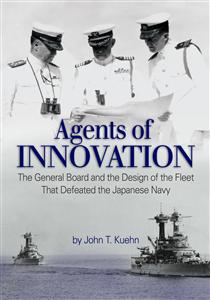 I like innovators so it was only natural that I “e-interview” John Kuehn, Assistant Professor of Military History at the U.S. Army Command and General Staff College and author of Agents of Innovation: The General Board and the Design of the Fleet That Defeated the Japanese Navy.
I like innovators so it was only natural that I “e-interview” John Kuehn, Assistant Professor of Military History at the U.S. Army Command and General Staff College and author of Agents of Innovation: The General Board and the Design of the Fleet That Defeated the Japanese Navy.
What was the General Board and how did it contribute to the defeat of the Japanese Navy?
The General Board of the Navy was established by Secretary of the Navy John D. Long with General Order 544 on March 13, 1900. It was composed of senior naval officers, mostly flag rank and captain level, although it included at various times more junior Navy and Marine Corps officers. The Secretary for the Board was usually a commander or lieutenant commander of particular promise (Robert Ghormley and Thomas Kinkaid were secretaries of the General Board as junior officers). The General Board, officially only advisory in nature, effectively served as a naval general staff until the creation of the position and staff for the Chief of Naval Operations in 1915. After that point it still had oversight of naval strategy and for most of its life remained the ultimate authority on fleet design to match the policy ends of the Secretary. Because of its authoritative influence on ship design it can be regarded as the author and father of the fleet that went to war with the Japanese in 1941. It was disestablished shortly after the “Revolt of the Admirals” in 1950 at the instigation of the second Secretary of Defense Louis Johnson.
What widely viewed views about the Washington Naval Treaty do you dispel in Agents of Innovation?
The biggest myth is that the Washington Naval Treaty had a uniformly negative effect on naval innovation and design (this myth propagated by S.E. Morison). As the book attempts to show (and my dissertation in far more detail), the Treaty had the impact-especially through Article XIX, what I call the fortification clause-in spurring the Navy to build the blueprint (if not most of the ships and systems) for a nearly land-base independent power projection fleet in order to execute a step by step island hopping campaign to retake the Philippines and then strangle Japan economically. This was the pre-war Orange Plan which goes hand in hand with the Treaty in shaping the design of the fleet. Another view I attempt to dispel is that of the battleship admirals versus the air admirals…this view is too narrow. The admirals all shared a common sea power ideology and were really “fleet” admiral. What I found remarkable was the relative homogeneity of the their views rather than stark differences. The notion that the Navy as an institution did not properly value air power in the interwar period is simply not true.
How did the General Board link the treaty system with innovation in the design of the fleet?
The Navy published, right after the Washington Treaty, its first ever “U.S. Naval Policy 1922,” a remarkable document which it distributed in handbill form throughout the fleet to acquaint everyone with the how the Washington Naval Treaty linked to the fleet. This document is Appendix 2 in my book and shows in great detail how the “U.S. Naval Policy [is] Based on Treaty for Limitation of Naval Armament.” This document was written by the General Board and designed to be good for ten years, with annual reviews.
What were some of the innovative modernization programs and initiatives that the U.S. Navy was forced to implement as a result of the Washington Naval Treaty?
The book looks specifically at three programs: battleship modernization (using the reconstruction clause of the Washington Naval Treaty), the mobile base plan of War Plan Orange (especially the floating dry dock program which became an especially dear project to the General Board), and how the Treaty reflected innovation in naval aviation through the flying deck cruiser initiative. It could have addressed a number of other issues as well-but that would have made for a much longer book. This year one of my students completed a master thesis on the General Board’s role in the design of fleet submarines and its positive effect on the design and evolution that lead to the production of the Gato-class boats. These submarines were highly successful in conducting unrestricted submarine warfare in World War II. All of these positive developments included the General Board as a sort of “final clearing house” and occurred within and in part because of the constraints of the Washington Naval Treaty.
What are the lessons learned from Agents of Innovation for today’s 21st Century Navy?
The U.S. Navy is basically in an interwar period right now-the current operations in Iraq and Afghanistan, despite what the pundits might say, are land-centric with the Navy in a supporting role. Our command of the sea for these operations is not in jeopardy. Although not constrained by a naval arms limitation treaty per se, we are constrained by budgets and a very uncertain security environment. So I think if naval officers want to understand the dynamics of building a fleet in an uncertain environment during peacetime and with declining budgets, then the interwar period and the General Board’s collaborative and collegial approach have much to teach us. The General Board had one advantage over us, they clearly identified the threat as Japan…which made war plans and design simpler (although not necessarily easy-see Clausewitz Book I chapter 7 on friction). The threat is nebulous…and dependent on policy. The old Mahanian solution of building against the most capable foreign navy does not work today because the U.S. Navy is clearly the most capable navy on the face of the earth right now, it wasn’t that way in 1919. In some sense our challenge is much greater than the General Board faced, but I think their basic approach, as reflected in my book, had much wisdom in it.
Who should read Agents of Innovation?
The same people to whom I would recommend On War by Carl von Clausewitz, anyone interested in the national defense of the United States-ie. all concerned U.S. citizens. The United States is essentially a continental island which relies overwhelmingly on maritime trade-islands need navies for their defense. This is just Mahan 101. National defense is everybody’s business, not just wonks/retired officers like me who teach at war colleges. At the very minimum field grade /lieutenant commanders and higher military professionals and national level politicians and policy makers, and those who aspire to be such, should read this book.
Is there anything else you would like to add?
Thank you for this opportunity to discuss my work and my book. It is not the last word on the General Board and the interwar navy. The books of Thomas and Trent Hone, Norman Friedman, Mark Mandeles, Edward Miller, Williamson Murray, and Allan Millett and others also provide wonderful viewpoints on this critical period. There remains much research to be done.
Read widely and deeply, its less hazardous than learning the hard the way in the real world.

